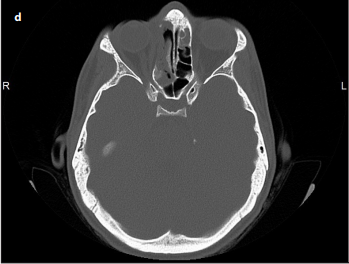Objective: Osteomas represent the most common benign tumors of the paranasal sinuses. In spite of being slow-growing and usually asymptomatic, osteomas can cause symptoms depending on their size, location, and extension to the adjacent anatomical structures. The aim of this study was to investigate and discuss the clinical features and surgical management of patients with paranasal sinus osteomas who were treated in one center.
Material and Methods: A retrospective chart review of 40 patients undergoing surgical treatment for paranasal sinus osteoma between January, 2005 and December, 2019 was carried out. Patients’ demographic characteristics, presenting symptoms, osteoma size and location, imaging findings, and surgical outcomes were analyzed.
Results: The mean duration of follow-up was 31 months (range, 6-122 months). The most frequently affected site was the frontal sinus (55%), followed by the frontoethmoid region (27.5%) and the ethmoid sinus (7.5%). Headache was found to be associated with frontal sinus osteomas (p=0.014). Besides, extra-sinusal extension was observed in 10 (25%) patients. While 20 (50%) patients were treated with a purely endonasal endoscopic technique, an external technique was most commonly used for frontal sinus osteomas (p=0.035). There were no major surgical complications in 33 patients (85%); complete resection, however, could not be successfully achieved in 6 patients (15% residual tumor rate), 2 of whom subsequently underwent revision surgery (5% revision rate).
Conclusion: Paranasal sinus oteomas are benign, slow-growing, and usually asymptomatic lesions with potentially important complications. That being said, surgical removal remains the treatment of choice for symptomatic or rapidly growing osteomas of the paranasal sinuses.
Cite this article as: Pamuk AE, Kılıç B, Özer S, Süslü AE, Önerci M. Paranasal Sinus Osteomas: Surgical Outcomes at a Single Institution. Eur J Rhinol Allergy 2020; 3(1): 4-9.

.png)
_page-0001.jpg)
.png)
